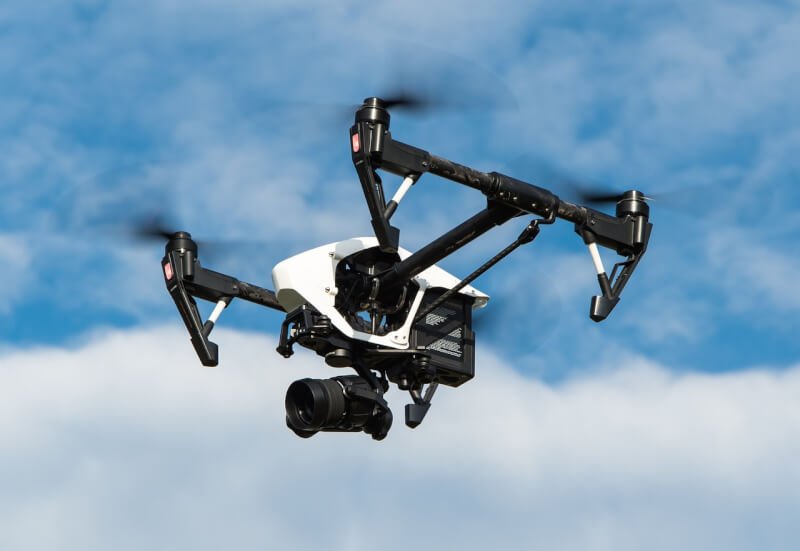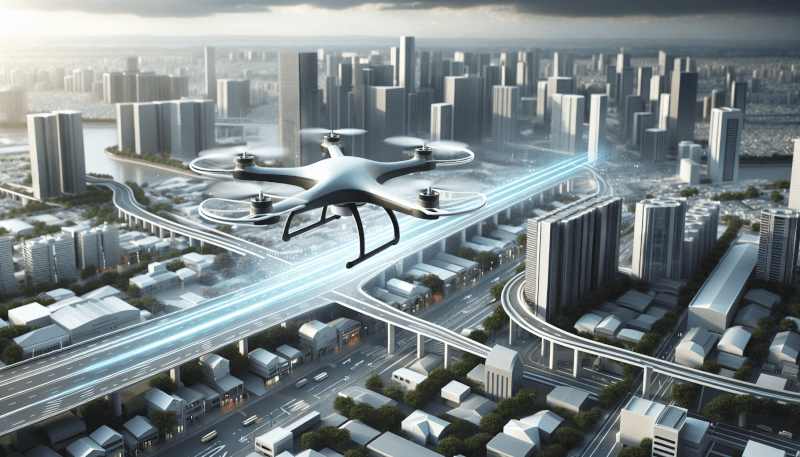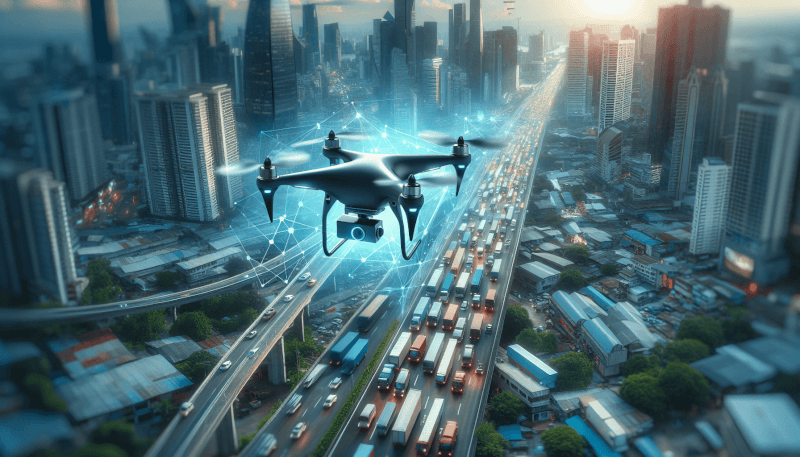Imagine a world where packages are swiftly delivered by sleek flying machines, transporting goods faster and more efficiently than ever before. This is the future that drone technology promises to bring to the transportation and logistics industries. With advancements in unmanned aerial vehicles, companies are exploring the immense potential of drones to revolutionize the way we transport goods, improving speed, reducing costs, and expanding reach. In this article, we will explore the impact of drone technology on these industries, uncovering the exciting possibilities that lie ahead.

E-commerce Delivery
More Efficient Last-Mile Delivery
Drone technology has revolutionized last-mile delivery in the e-commerce industry. With the ability to fly directly to customers’ homes, drones offer a more efficient and direct route for delivering packages. Traditional delivery methods often face challenges such as traffic congestion and unpredictable road conditions, leading to delays and inconveniences for consumers. However, drones can bypass these obstacles, enabling faster and more reliable delivery.
Faster Shipping Times
One of the significant advantages of utilizing drones for delivery is the reduction in shipping times. Traditional delivery methods can take days or even weeks to transport goods from warehouses to customers. With drones, packages can be dispatched swiftly, resulting in significantly faster shipping times. This increased speed is particularly beneficial for time-sensitive shipments, such as perishable goods or urgent medical supplies.
Reduced Delivery Costs
Another remarkable impact of drone technology on e-commerce delivery is the potential for reduced costs. Traditional delivery methods often involve large fleets of vehicles, fuel expenses, and maintenance costs. By incorporating drones into the delivery process, companies can significantly cut down on these expenses. Drones require less fuel, have minimal maintenance needs, and can cover long distances more efficiently. These cost savings can be passed on to customers, resulting in more affordable delivery services.
Inventory Management
Real-Time Inventory Tracking
Drones play a crucial role in improving inventory management through real-time inventory tracking. With drones equipped with advanced sensors and cameras, businesses can accurately locate and monitor their inventory in real-time. This enables a rapid and accurate assessment of stock levels, ensuring that products are adequately accounted for and minimizing the risk of stockouts or overstocking.
Improved Inventory Accuracy
In addition to real-time inventory tracking, drones can enhance inventory accuracy. By utilizing drones for regular inventory checks, businesses can significantly reduce human error and improve the accuracy of inventory records. Drones can scan barcodes and RFID tags quickly and accurately, enabling businesses to have up-to-date and reliable inventory data.
Reduced Stockouts and Overstocking
Inventory management is also improved with the help of drones as they minimize the occurrence of stockouts and overstocking. By providing real-time tracking and accurate inventory information, businesses can maintain optimal stock levels. This reduces the chances of running out of popular items, keeping customers satisfied, while also preventing overstocking, which can tie up valuable resources and incur unnecessary costs.
Warehouse Operations
Increased Efficiency in Picking and Packing
Drone technology offers increased efficiency in warehouse operations, particularly in the picking and packing process. Instead of relying solely on manual labor, drones can assist in the retrieval of items from shelves and the transportation of packages within the warehouse. This automation improves overall efficiency, reduces errors, and speeds up the fulfillment process.
Automated Sorting and Storing
Drones can also automate sorting and storing tasks in warehouses. Equipped with advanced navigation systems and object recognition technology, drones can identify items and store them in designated locations. This eliminates the need for manual sorting and reduces the risk of misplacing or mislabeling items. By automating these processes, businesses can achieve higher accuracy and efficiency in warehouse operations.
Improved Safety Measures
Safety is a crucial concern in warehouse operations, and drones can contribute to safer working environments. By taking over repetitive and physically demanding tasks, drones can reduce the risk of injuries and accidents for warehouse workers. They can also be equipped with collision avoidance technology to prevent collisions with other objects or employees. Overall, drones help improve safety measures in warehouses, leading to a healthier and more productive workforce.
Supply Chain Optimization
Reduced Lead Times
Drones have the potential to significantly reduce lead times in the supply chain. With their ability to travel quickly and directly, they can expedite the movement of goods from suppliers to manufacturers, and from manufacturers to retailers or customers. This reduction in lead times allows businesses to respond more rapidly to customer demands, improving overall supply chain efficiency.
Enhanced Visibility and Traceability
One of the critical challenges in supply chain management is visibility and traceability. Drones can provide enhanced visibility by providing real-time updates on the movement of goods throughout the supply chain. This enables businesses to track shipments, identify bottlenecks, and proactively address any issues that may arise. With improved traceability, businesses can ensure compliance with regulations and maintain transparency in their supply chain.
Streamlined Reverse Logistics
Reverse logistics, involving the return of goods from customers back to the retailer or manufacturer, can be a complex process. Drones can streamline reverse logistics by enabling swift and efficient returns. Customers can send back their items using drones, eliminating the need for manual returns processing and reducing turnaround times. This seamless reverse logistics process enhances customer satisfaction and improves overall supply chain operations.

Drones for Surveillance
Enhanced Security Measures
Drone technology has also made significant contributions to enhancing security measures in various industries, including transportation and logistics. Drones equipped with surveillance cameras and thermal imaging capabilities can monitor large areas and detect potential threats more effectively. Whether it’s guarding critical infrastructure or ensuring the safety of warehouse facilities, drones provide an added layer of security.
Improved Monitoring of Critical Infrastructure
Critical infrastructure, such as airports, seaports, and railway networks, require constant monitoring for safety and security purposes. With drones, the monitoring process becomes more efficient and comprehensive. Drones can cover large areas quickly, inspect vulnerable areas, and detect any potential issues or breaches. This improves the overall surveillance and monitoring of critical infrastructure, enhancing safety and reducing the risk of unauthorized activities.
Faster Response to Security Threats
When it comes to responding to security threats, time is of the essence. Drones enable a faster response to security threats by providing real-time situational awareness. They can deploy quickly to the location of the threat, capture live video footage, and relay critical information to security personnel. This rapid response capability allows for more effective decision-making and faster implementation of security measures.
Environmental Impact
Reduced Emissions
Drone technology offers significant environmental benefits through reduced emissions. Traditional delivery methods heavily rely on vehicles that contribute to air pollution and greenhouse gas emissions. By incorporating drones into delivery operations, companies can reduce their carbon footprint and help combat climate change. Drones operate on electric power, resulting in minimal emissions and a cleaner environment.
Lower Energy Consumption
In addition to reduced emissions, drones also have lower energy consumption compared to traditional delivery methods. Drones are lightweight and require less energy to operate, making them more energy-efficient. With the increasing demand for delivery services, the adoption of drones can contribute to overall energy conservation by minimizing the energy required for transportation.
Sustainable Delivery Solutions
The environmental impact of transportation and logistics has become a growing concern. Drones provide a sustainable delivery solution that aligns with the goals of environmental sustainability. By reducing emissions, lowering energy consumption, and utilizing electric power, drones offer a greener alternative to traditional delivery methods. Their adoption contributes to a more sustainable future for the transportation and logistics industries.

Regulatory Challenges
Integration of Drones into Existing Airspace Regulations
As drone technology continues to advance, regulatory challenges arise in integrating drones into existing airspace regulations. Safety and airspace management are critical concerns that require careful coordination between drone operators and regulatory authorities. Developing guidelines and regulations that ensure the safe operation of drones while maintaining airspace integrity is crucial for the widespread adoption of drone technology.
Privacy Concerns and Data Protection
The use of drones for surveillance purposes raises privacy concerns and the need for data protection. Drones equipped with cameras can capture images and videos, potentially invading individuals’ privacy. It is essential to establish regulations that govern the collection, storage, and use of data obtained by drones. Protecting individuals’ privacy rights and ensuring the secure handling of data are paramount in the development of drone technology.
Insurance and Liability Issues
Insurance and liability matters are also significant regulatory challenges in the adoption of drone technology. Accidents involving drones can result in property damage, personal injuries, and other liabilities. Establishing insurance requirements and determining liability in case of accidents or incidents involving drones is crucial for ensuring accountability and providing appropriate compensation. Collaborative efforts between drone manufacturers, operators, and insurance providers are necessary to address these challenges.
Job Displacement and Skills Development
Changing Workforce Dynamics
The introduction of drone technology may lead to changes in workforce dynamics within the transportation and logistics industries. As some tasks become automated, the roles and responsibilities of human workers may evolve. While certain jobs may be displaced by drones, new opportunities and roles may also emerge. Adapting to these changing workforce dynamics requires a proactive approach to skills development and training.
New Job Opportunities in Drone Operations
The adoption of drone technology creates new job opportunities in the field of drone operations. As more companies incorporate drones into their operations, they require skilled professionals to operate, maintain, and manage the drones. Jobs such as drone pilots, operators, technicians, and data analysts become essential in ensuring the successful integration and utilization of drones in transportation and logistics.
Skill Development for Drone Technology
To meet the demand for skilled professionals in drone operations, there is a need for skill development and training programs. These programs should focus on providing individuals with the knowledge and expertise required to operate drones safely and effectively. Training can include piloting skills, understanding drone regulations, data analysis, and maintenance. Skill development initiatives empower individuals to adapt to the changing landscape of the transportation and logistics industries.

Infrastructure Requirements
Development of Drone Ports and Charging Stations
The advancement of drone delivery services necessitates the development of dedicated infrastructure. Drone ports, similar to traditional airports, would serve as hubs for drone operations. These ports would facilitate the take-off and landing of drones, as well as provide charging stations for recharging the drones’ batteries. The development of such infrastructure is crucial for the seamless integration and scalability of drone delivery services.
Implementing Air Traffic Management Systems for Drones
As the number of drones in the airspace increases, implementing air traffic management systems specifically designed for drones becomes essential. These systems would enable the safe and efficient coordination of drone flights, ensuring that drones operate within designated flight paths and avoid collisions. An effective air traffic management system would enhance the overall safety and reliability of drone operations.
Integration with Existing Transport Infrastructure
To fully realize the potential of drone technology in transportation and logistics, integration with existing transport infrastructure is necessary. This includes integrating drones into current logistics networks, such as connecting drones with warehouses and distribution centers. Integration also involves developing communication protocols and interfaces that allow seamless collaboration between drones and other transportation modes.
Future Outlook
Expansion of Drone Delivery Services
The future outlook for drone technology in the transportation and logistics industries is promising, with an expected expansion of drone delivery services. As technology continues to advance, drones will play an increasingly prominent role in last-mile delivery, further reducing shipping times and costs. The expansion of drone delivery services will provide consumers with faster and more convenient delivery options while pushing the boundaries of efficiency in the industry.
Integration of Artificial Intelligence and Autonomous Operation
As drone technology evolves, the integration of artificial intelligence (AI) and autonomous operation capabilities will become more prevalent. AI algorithms can enable drones to make intelligent decisions, navigate complex environments, and adapt to changing conditions. Autonomous operation allows drones to perform tasks without remote control, enhancing efficiency and reducing the reliance on human intervention.
Emerging Technologies in Drone Transportation
Beyond delivery services, emerging technologies in drone transportation continue to drive innovation in the transportation and logistics industries. This includes the exploration of autonomous aerial taxis, drones for urban transportation, and even cargo drones capable of lifting heavy loads. These emerging technologies present exciting possibilities for the future of transportation, shaping the way goods and people are transported and revolutionizing the industry as a whole.
In conclusion, drone technology has had a profound impact on the transportation and logistics industries. From e-commerce delivery to inventory management, warehouse operations, supply chain optimization, surveillance, environmental impact, regulatory challenges, job displacement, infrastructure requirements, and future outlook, drones have brought about significant improvements and transformative changes. With further advancements, the widespread adoption of drone technology is poised to revolutionize how we transport goods, monitor security, address environmental concerns, and shape the workforce of the future. The transportation and logistics industries stand at the brink of a new era powered by drones, ready to embrace the benefits and overcome the challenges that lie ahead.



